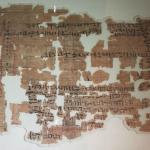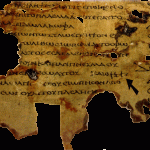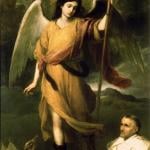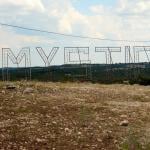Atheist and prolix critic of Christianity and the Bible Bob Seidensticker runs the popular and influential Cross Examined blog. This is my 83rd critique of his articles (no counter-reply as of yet). He was gracious enough to send me a free e-book copy of his new volume, 2-Minute Christianity: 50 Big Ideas Every Christian Should Understand (May 2022), which I critiqued point-by-point. His words will be in blue.
*****
This is a reply to portions of Bob’s article, “Defending the Bible with undesigned coincidences” (2-13-23). Bob will be informed in a personal letter of this response.
Searching for undesigned coincidences is an exciting new pastime within Christian apologetics. Well, maybe not new—it’s an exciting revived pastime. Undesigned Coincidences in the Writings Both of the Old and New Testament was published in 1854, and other books preceded it.
It’s a fascinating and fruitful subject matter, for sure. My friend Lydia McGrew (traditional Anglican) has published the book, Hidden in Plain View: Undesigned Coincidences in the Gospels and Acts (2017).
More important, these two gospels don’t tell the same story. In Matthew, the beating comes from members of the Sanhedrin, at the end of the trial. But in Luke, it’s guards who beat Jesus, and then he’s taken to the Sanhedrin.
Let’s see if we can find actual proof one of the infamous “contradictions” dreamt up by atheists, between Matthew and Luke. Matthew provides the story of Peter’s denial of Christ immediately after stating:
Matthew 26:67-68 (RSV) Then they spat in his face, and struck him; and some slapped him, [68] saying, “Prophesy to us, you Christ! Who is it that struck you?”
Luke presents the same story of Peter right before the same incident:
Luke 22:63-65 Now the men who were holding Jesus mocked him and beat him; [64] they also blindfolded him and asked him, “Prophesy! Who is it that struck you?” [65] And they spoke many other words against him, reviling him.
Clearly, both believe that Peter’s denial occurred at roughly the same time as this “beating” incident (during a portion of Jesus’ kangaroo court trial). Neither specifically note that the Peter incident was before or after the other in time, so there is no undeniable contradiction. Nor is it necessary to even know that detail. Witnesses (or Peter’s own report) wouldn’t have known exactly what was happening inside the building or when any given thing happened, since they were outside of it. Chronology in the Bible, in any event, was not viewed in a strictly linear fashion, like we do today (that’s much more of Greek thing than a Hebrew / Semitic thing). Topical similarities are relatively more important.
Seidensticker claims there is a contradiction between guards beating Jesus in one account, and the Sanhedrin doing so in the other, and in the two chronologies presented. But is there, really? Luke describes them as “the men who were holding Jesus.” But earlier in his text, he reveals that the same men were “the chief priests and officers of the temple and elders, who had come out against him” (Lk 22:52), who “seized him and led him away, bringing him into the high priest’s house” (22:54).
Therefore, they weren’t merely “guards” (we know for sure). Matthew is less specific in the immediate context: “those who had seized Jesus led him to Ca’iaphas” (26:57). But earlier he, too, identifies them as, specifically, “the chief priests and the elders” (26:47). Matthew mentions, in harmony with Luke, that there were “elders” (Mt 26:57) and “chief priests” (26:59) at the trial. Luke likewise mentions those two categories of people at the trial (Lk 22:66).
Everything is exactly the same except that Luke added the non-contradictory additional category of “officers of the temple” among those who seized Jesus. Neither uses the word “guard.” That is Bob’s mere guess. But granted, these people were “holding” Jesus, and so that is guarding Him. In any event, it’s the same groups of people in both accounts: those who were part of the council.
The harmonization of the two accounts seems clear and obvious to me: some of the “elders” and chief priests” who were among those present at the trial went out to seize Jesus, having obtained information as to His whereabouts from Judas. Matthew states that Judas “went to the chief priests” (Mt 26:14) to betray Jesus. Luke reports that “he went away and conferred with the chief priests and officers how he might betray him to them” (Lk 22:4). And so he noted that “chief priests and officers” (acting on this information) seized Jesus (22:52, 54).
We find the same in Mark. Judas went to the “chief priests” (Mk 14:10), and the ones who seized Jesus were “from the chief priests and the scribes and the elders” (Mk 14:43): the same three groups of people who were in the assembly (Mk 14:53). Mark does say that “guards” struck Jesus (Mk 14:65), but there is no reason to not believe that they were from among the assembly. Furthermore, John states that Judas came with “a band of soldiers and some officers from the chief priests and the Pharisees” (Jn 18:3; cf. 18:12).
The same people were guarding Him — were close to Him — during the trial (while they were part of the deliberations) and struck him in mockery and hatred. They were part and parcel of the council. Thus, no inexorable contradiction whatsoever is present. Atheists like Bob are quick to claim “contradiction!” But it’s almost always a superficial analysis (nothing like what I have just provided). They don’t demonstrate or prove how they can’t possibly be harmonious accounts. The analyses lack logical rigor, to put it mildly.
So what is an undesigned coincidence? Tim McGrew defines it this way:
Sometimes two works written by different authors incidentally touch on the same point in a manner that cannot be written off as copying or having a copy made from some third source.… The two records interlock like the pieces of a jigsaw puzzle.
Yes; this happens all the time in the Bible. I know, because I’ve been defending it against innumerable atheist charges of contradiction, that invariably come to nothing. I hope that this will be my next officially published book: Anti-Bible: Refutations of XXX Alleged Biblical Contradictions. My solution above will be added to it.
Sure, let’s say that the books of the New Testament have omissions. That makes them look like ordinary books written with no supernatural oversight.
No; it makes them look like books written in the ordinary manner (and able to be interpreted by means of reason) before we get to the question of inspiration or even their religious or theological nature, generally speaking. All of this analysis is of that sort. A supernatural inspired and infallible revelation would have to, by definition, be free from error, or at least significant error (beyond an extra zero added, or likely mere manuscript transmission errors, etc.). That’s why the discussion of alleged contradictions is important.
If and when the Christian apologist debunks these, he is showing that the Bible is accurate, which is consistent with inspiration, but doesn’t prove it. If he doesn’t succeed, then the doctrine of inspiration would be in significant trouble. We solve the alleged contradictions in order to prove biblical accuracy, not inspiration, which is a much more complex additional matter. Accuracy of hundreds of details confirms overall accuracy, by cumulative argument, and suggests a possible inspiration. And this is important in and of itself, as just explained.
This is like the Argument from Accurate Place Names, which praises the Bible for recording the names for many places that are later confirmed by history or archaeology. Big deal.
Yes it is a big deal, because the Bible has often been accused of getting these details wrong, because (so the skeptic claims) it’s not inspired. Demonstrating accuracy in this respect shows that the Bible has characteristics (accuracy of place names) which are consistent with, and a prerequisite to, inspiration. Both sides have to be aware of the logic and epistemology involved, and what is being claimed for any given argument.
***
Practical Matters: Perhaps some of my 4,000+ free online articles (the most comprehensive “one-stop” Catholic apologetics site) or fifty-one books have helped you (by God’s grace) to decide to become Catholic or to return to the Church, or better understand some doctrines and why we believe them.
Or you may believe my work is worthy to support for the purpose of apologetics and evangelism in general. If so, please seriously consider a much-needed financial contribution. I’m always in need of more funds: especially monthly support. “The laborer is worthy of his wages” (1 Tim 5:18, NKJV). 1 December 2021 was my 20th anniversary as a full-time Catholic apologist, and February 2022 marked the 25th anniversary of my blog.
PayPal donations are the easiest: just send to my email address: [email protected]. You’ll see the term “Catholic Used Book Service”, which is my old side-business. To learn about the different methods of contributing, including 100% tax deduction, etc., see my page: About Catholic Apologist Dave Armstrong / Donation Information. Thanks a million from the bottom of my heart!
***
Photo credit: darksouls1 [Pixabay / Pixabay license]
***
Summary: Atheist Bob Seidensticker says Matthew & Luke differ about who mocked and beat Jesus at His trial. I prove the contrary, and also the harmony of several related facts.
***














